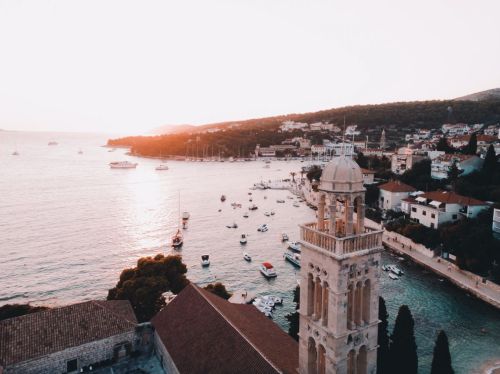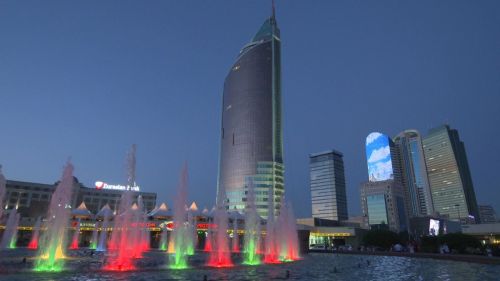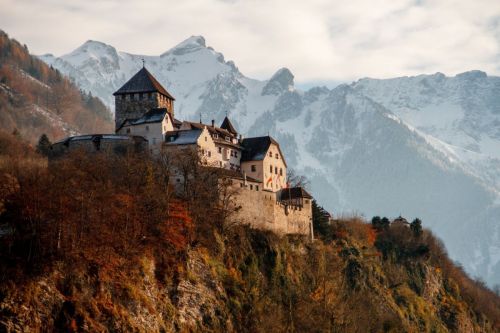Albania is a small country located on the Balkan Peninsula. This small and economically underdeveloped country is characterized by a mountainous landscape and a Mediterranean climate.
It borders Montenegro and Kosovo to the north, Macedonia to the east, and Greece to the south. In the west, the natural border is the coast of the Adriatic and Ionian Sea - Albania is one of the Mediterranean countries.
Albania is separated from Italy by the 72 km Strait of Otranto - a strait connecting the Adriatic Sea with the Ionian Sea and separating the Apennine and Balkan peninsulas. The strait was of particularly strategic importance during World War I.
It is a country slightly smaller than Belgium, and with 2.82 million inhabitants it has approximately three-quarters of the population of Bosnia and Herzegovina.
One of the symbols of the state is the flag of Albania, which since 1992 is a red rectangle with a black double-headed eagle in the middle. Flag Day is celebrated on November 28.
Another symbol of this country is the coat of arms, which is based on the seal of Skanderbeg, an Albanian national hero from the 15th century. It depicts a black two-headed eagle on a red shield.
Since 2002, there has been a golden drawing of "Skanderbeg's helmet" above the eagle. The double-headed eagle was the emblem of the Byzantine Empire (Eastern Roman Empire).
Tirana is also the largest city in Albania, the largest industrial center, and the country's cultural center. The city lies on three rivers: Lana, Tirana and Tërkuzë. There are seven universities there, the most important of which is the University of Tirana, founded in 1957.
The main monument of the city is the Ethema Beja mosque from the 18th century.
Areas above 1000 m above sea level they constitute 28.8% of the country's area. The mountains in Albania are the southern extension of the great Balkan chain of the Dinaric Mountains.
The most extensive mountain ranges are the Albanian Alps in the north, the Korab Mountains in the east, the Pindus Mountains in the southeast, and the Skanderbeg Mountains in the center of the country. The highest peak in the country is Maja e Korabit, 2764 m above sea level, situated on the border with Macedonia.
One of the most extraordinary features of southern Albania is the Ceraunia Mountains, stretching for approximately 100 km, which fall vertically into the Mediterranean Sea. Within the Central Albanian Mountains lies the Korçë Valley, which is the largest valley in the country. Its bottom lies at an altitude of approximately 800 m above sea level.
The mountainous areas of Albania are in many places crossed by river valleys.
The coastal zone is occupied by the Albanian Plain. It is covered with marine and river sediments.
In the northwest, there is the largest lake in Southern Europe - the karst Lake Skadar, located on the border of Albania and Montenegro.
In the southeast of the country, there is Lake Ohrid, which is one of the oldest continuously existing lakes in the world. It is one of the deepest and oldest lakes in Europe, with a unique aquatic ecosystem of global importance, with over 200 endemic species.
The shores of Lake Ohrid in North Macedonia were included on the UNESCO World Heritage List in 1979, and in 1980 the area was expanded to include the cultural and historical area of Ohrid. The Albanian side of Lake Ohrid was also inscribed on the UNESCO World Heritage List in 2019.
In 2010, NASA named one of Titan's lakes after Lake Ohrid.
Lake Prespa lies at the junction of North Macedonia, Albania and Greece. It is a system of two lakes separated by an isthmus. These are the highest tectonic lakes in the Balkans. They are located at an altitude of 853 m. They are home to 9 endemic fish species.
The river is 335 km long, of which 285 km flows through Albania and the rest through Kosovo and North Macedonia.
The most widespread terrestrial ecosystem is forests, which cover 36% of the country's area. The forests of northern Albania are similar to those of continental Europe, and the forests of southern Albania resemble those of the Mediterranean Basin.
They are dominated by deciduous trees (56.8%). These are mainly oaks (12 species) and beeches (18.4%). Coniferous forests constitute 16.4% of the total forest area. They are dominated by black pine, which is one of the most important tree species in the country.
Albania has a wealth of wetland ecosystems supporting diverse and unique habitats. The richest wetland regions are found in particular on the coastal plain.
Over 353 bird species have been recorded there, including 11 globally endangered species. There are many species of birds of prey there, including eagles, hawks, falcons, and vultures.
Eagles are widespread throughout the country, with different species inhabiting different habitats. The largest bird of prey is the golden eagle. It occurs mainly in mountainous areas and cliffs.
One of the most famous wildlife species in Albania is the brown bear, which is one of the most valuable elements of biodiversity and also plays an important role in maintaining biodiversity. It occurs in a large part of the country (the second largest population in Europe).
One of them has been designated as a marine park (Karaburun-Sazan).
In ancient times, the areas of today's Albania were inhabited by Illyrian, Thracian, and Greek tribes. In the 3rd century BC, these areas were annexed by Rome and became part of the Roman provinces of Dalmatia, Macedonia, and Moesia.
These territories remained under Roman and Byzantine control until the migration of the Slavs in the 7th century and were integrated into the Bulgarian Empire in the 9th century.
Some areas became part of the Venetian Empire and later Serbia. Between the 14th and 15th centuries, most of modern Albania was dominated by the Albanian principalities until their fall due to the invasion of the Ottoman Empire.
Albania remained under Ottoman control until 1912 when the first independent Albanian state was established.
After the fall of the Axis powers, Albania became a communist state - the People's Socialist Republic of Albania - until the fall of the Eastern Bloc in 1990.
After the fall of the communist regime, social unrest emerged amid economic collapse, which led to an Albanian diaspora in the 1990s, mainly in Italy, Greece, Switzerland, Germany, and North America.
The economic crisis culminated in the civil war in 1997, which claimed over a thousand lives. As a result of early elections, the post-communist opposition came to power.
After eight years in power, the Socialist Party of Albania lost power, and in 2005 it was taken over by a coalition of opposition parties led by the Democratic Party.
Its accession to the EU is supported by 96% of citizens. Albania has been a member of NATO since 2009.
The north of the country is inhabited by the Ghegs, who speak the Gheg Albanian dialect, and the south by the Tosks, who speak the Tosk Albanian dialect, which is the basis for the codification of the modern literary language of Albania.
Knowledge of Greek is common among the Tosks. Their community is bi-religious - the majority professes Islam, while Orthodox believers are a minority there.
The Ghegs are also bi-religious, with the majority professing Islam, but a minority group are Catholics.
Homer in "The Iliad" wrote that the land beyond the Acrokerunian Mountains is inhabited by giants. The Ghegs were also described as Balkan Cyclopes and were considered the tallest inhabitants of the Balkans.
56.7% of Albania's population professes Islam, making it the largest religion in the country, and Albania is the only country located entirely in Europe where Muslims constitute the majority of the population. Most Albanian Muslims are Sunni.
Christianity is mainly represented by Catholicism (10.03%) and Orthodox Christianity (6.75%). Christianization of Albania lasting from the 1st century AD finally took place in the Greek rite.
For several decades, Albania was under the rule of a communist activist, Enver Hoxha, who promoted state atheism. At that time, religion was banned and condemned.
900 tons of marijuana were produced there annually, worth €4.5 billion, or slightly less than half of Albania's GDP. Contractors from the Netherlands, Germany, Italy, and all over the Balkans came there every day. They paid 500-800 euros for a kilogram of marijuana.
Legend has it that when purchased for personal use, for "legal" consumption, the promotional price for locals was €350 per kilogram.
The procedure ended when Albania wanted to join the European Union. Today, in addition to the police, military units are stationed in Lazarat to ensure the normal functioning of the village. However, there is no certainty that a new marijuana capital of Europe is not being built somewhere in the Gjerë Mountains.
There are several hundred thousand shelters, commonly known as bunkers. They were built between 1972 and 1984. The decision to fortify the state was made at the 12th Plenum of the Central Committee of the Party of Work of Albania in 1971.
Currently, there is a "Concrete Mushrooms" campaign encouraging the use of shelters.
Vine was naturally cultivated there already in the Ice Age. The oldest seeds found there are between 4000 and 6000 years old.
In 2009, the country produced approximately 17.500 tons of wine.
Romania ranks first.
Albania has the 10th largest oil reserves in Europe and 58th in the world. It is also a significant producer of minerals and is one of the world's producers and exporters of chromium. It is also a leading producer of copper, nickel, and coal.
Most of the tourism industry is concentrated along the Adriatic and Ionian Seas in the west of the country. However, the Albanian Riviera in the southwest of the country has the most pristine, picturesque beaches and is often called the pearl of the Albanian coast.
Other tourist attractions are mountainous areas: the Albanian Alps, the Ceraunia Mountains, the Korab Mountains, as well as the historical cities of Berat, Durres, Gjirokaster, Saranda, Shkodër and Korçë.
Belong to them:












